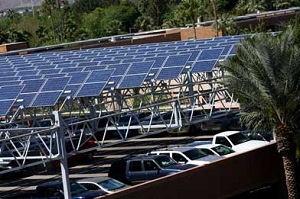Arizona State University tenures solar project
 Fully half of Arizona State University’s (ASU’s) West campus in Phoenix will be powered by locally installed photovoltaics (PVs) by the end of 2010. The university is installing 17,000 PV panels over three parking structures and an adjacent field to provide power on campus. The system will provide 4.65 megawatts (MWs) of PV power on the campus when completed and will consist of 10,000 panels covering three parking structures and 7,000 more in an adjacent field, according to The Arizona Republic, which reported on the project on Aug. 16.
Fully half of Arizona State University’s (ASU’s) West campus in Phoenix will be powered by locally installed photovoltaics (PVs) by the end of 2010. The university is installing 17,000 PV panels over three parking structures and an adjacent field to provide power on campus. The system will provide 4.65 megawatts (MWs) of PV power on the campus when completed and will consist of 10,000 panels covering three parking structures and 7,000 more in an adjacent field, according to The Arizona Republic, which reported on the project on Aug. 16.
According to Jason Scott, project manager for system installer APS Energy Services, the arrays are a pretty big deal.
"We'll be one of the largest parking canopy systems in the United States—definitely bragging rights," he said.
The solar installation is part of ASU’s solar initiative, an ambitious goal to put more than 15 MWs of PV power on its campuses in Tempe and Phoenix. As of March 2010, the university said it already had 2.04 MW of PV in operation, and 10.15 MW should be operational at the end of September 2010.
The project is being financed through a power purchase agreement with Solar Power Partners Inc., of Mill Valley, Calif. That firm will own and operate the $34 million project for a 15 year period, during which ASU will purchase the power generated at a fixed rate, the university said. With the fixed price for generated power, it ensures long term energy pricing stability for the university, which reduces the impact of rising energy costs from other power sources as they rise over time.
The Arizona Republic said that the power-purchase agreement “saves the cash-strapped university” from making the steep capital investment to install the panels. The deal also allows Solar Power Partners to take advantage of solar tax incentives offered by Arizona and federal government, for which the public university is not eligible.
The installation and ASU’s solar initiative are helping the university reach its carbon neutrality goals, which the school system began making progress toward when it completed its first solar installation on its Tempe campus in 2004.



